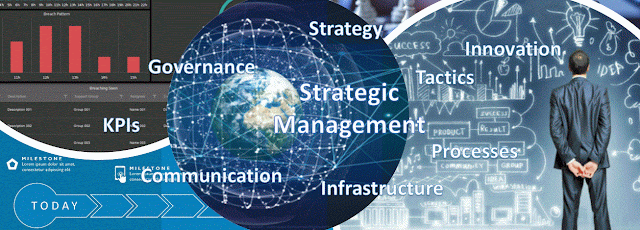 |
| Strategic Management Series |
Probably ERP Implementations are one of the most complex type of projects one deals with in the IT world, however their complexity seldom resides in technologies themselves, but in the effort that needs to be made by organizations before, during and post-implementations. Through their transformative nature ERP implementations have the potential of changing the whole organization if their potential is exploited accordingly, which is unfortunately not always the case. Therefore, the challenges don’t resume only to managing a project or implementing a technology, but also in managing change, and that usually happens or needs to happen at several levels.
Typically, the change is considered mainly at IT infrastructure and processual level, because at these levels most of the visible changes happen – that’s what steals the show. For the whole project duration is about replacing one or more legacy systems, making sure that the new infrastructure works as expected. The more an organization deviates from the standard the more effort is needed, and this effort can exhaust an organization’s resources to the degree that will need some time to recover after that, financially, but maybe more important from a vital point of view.
Even if the technological and processual layers are important, as they form the foundation on which an organization builds upon, besides the financial and material flow there are also the data, informational and knowledge flows, which seems to be neglected. Quite often that’s where the transformational potential resides. If an organization is not able to change positively these flows, on the long term the implementation will deal with problems people wished to be addressed much earlier, when the effort and effect would have met the lowest resistance, respectively the highest impact.
An ERP implementation involves the migration of data between source(s) and target(s), the data requirements, including the one of appropriate quality, being regarded in respect to the target system(s). As within the data migration steps the data are extracted from the various sources, enriched, and prepared for import into the target system(s), there is the potential of bringing data quality to a level which would help the organization further. It’s probably simpler to imagine the process of taking the data from one place, cleaning and enriching the data to bring it to the needed form, and then putting the data into the new system. It’s a unique chance of improving data quality without touching the source or target system(s) while getting a considerable value.
Unfortunately, many organizations’ efforts to improve the quality of their data stop after the implementation. If there’s no focus and there are no structures in place to continue the effort, sooner or later data’s quality will decrease despite the earlier made efforts. Investing for example in a long-term data quality improvement or even a data management initiative might prove to be an exploratory and iterative process in which mistakes are maybe made, the direction might need to be changed, though, as long learning is involved, in this often resides the power of changing for the better.
When one talks about information there are two aspects to it: how an organization arrives from data to actionable information that reach timely the people who need it, respectively how information is further aggregated, recombined, shared, and harnessed into knowledge. These are the first three layers of knowledge (aka DIKW) pyramid, and an organization’s real success story is in how can manage these flows together, while increasing the value they provide for the organization. It’s an effort that must start with the implementation itself, or even earlier, and continue after the implementation, as an organization seems fit.
Previous Post <<||>> Next Post
Written: Sep-2020, Last Reviewed: Mar-2024
No comments:
Post a Comment